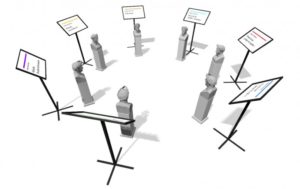Exploring Methods for Conveying Object Weight in Virtual Reality
 ...could we throttle the speed of a user’s actions when picking up objects to make things feel heavier or lighter?
...could we throttle the speed of a user’s actions when picking up objects to make things feel heavier or lighter?
As far as production software, we were torn between our familiarity with Unity and the rendering potential of Unreal. We stuck with Unity for now, and hope to explore Unreal more in future explorations.
Step 1: Becoming Pick Up Artists
You can’t explore weight without first nailing down the basic physics of how objects can be picked up and moved around, and we quickly found that these concepts were one in the same.
Step 2: Exploring Other Sensory Cues
In addition to the mechanics of lifting and grabbing, we felt it was important to explore other forms of feedback that could help convey an object’s weight. This manifested in two forms: visual and haptic feedback. In both cases, we tried to reinforce the amount of “strain” the user would feel as their controller approaches the thresholds of tension for a given object.
Step 3: Testing and Tweaking and Testing
With all of these factors, we had a seemingly endless list of permutations to explore. So to test and compare, we started working with multiple implementations in the same environment
Most of the primary differences weren’t even based on the physics — instead, they focused on the impact of secondary visual and haptic feedback on the physical interaction.
Testing
We created two scenes for user testing. In both, we arranged seven stations around the user. Our first scene had a single object per station, so testers could directly compare how it felt to pick something up using each method. As they worked through the stations, we asked a series of questions: Which object felt heaviest? Which method would you prefer if you had to pick up many objects? Which method felt the most natural?
Takeaways
While we saw a few high-level trends in our tests, no single implementation was a consensus top pick. This wasn’t unexpected; going into this exercise, we didn’t think there would ever be a ‘right’ answer. But we were able to draw plenty of conclusions from the input we received.
Loose Links Work Best When the Connection Can be Broken
But Unless It’s Vital to the Interaction, Weight Is an Annoyance
More Feedback is Welcome — and Don’t Forget Sound!
When we chose to add sound to this exercise, we didn’t think much of it. But it turned out to have a huge impact on how our testers perceived weight. The thuds of heavy objects hitting the ground or rubbing against each other reinforced the differences in mass.
‘Basic’ Interactions in VR Are More Complicated Than They Seem
See the full story here: http://www.roadtovr.com/b-reel-simulating-object-weight-mass-virtual-reality-motion-controllers
Pages
- About Philip Lelyveld
- Mark and Addie Lelyveld Biographies
- Presentations and articles
- Tufts Alumni Bio